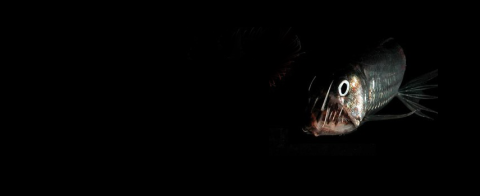The Open Ocean Trustees have approved a new Monitoring and Adaptive Management (MAM) Activity (PDF, 24 pages) that will collect and analyze data over three years of field work to assess benefits to fish and water column invertebrates, marine mammals, and sea turtles that can be attributed to Mesophotic and Deep Benthic Community studies with funding from the Deepwater Horizon oil spill.
The MAM activity—with an estimated budget of about $7.7 million—is anticipated to span five years, which includes three years of active field work to conduct data gathering activities.
This MAM Activity aims to gather new data to measure how different marine creatures and habitats are vertically connected. We'll study their distribution, abundance, behavior, and interactions within the water column, and between them and the broader Mesophotic and Deep Benthic Community. We'll use various tools, such as nets with environmental sampling gear and fish finders, along with environmental DNA and animal tissue stable isotope sampling. This will help us understand the communities of fish and invertebrates that live in the mid-water column, both during the day and at night.
These time periods coincide with the two extremes of their daily migrations within the water column. In the evening, they rise to the surface to feed overnight. In the morning, they descent for the day to hide from visual predators at darker depths. This behavior promotes food resource connectivity between the water column and deeper benthic habitats as they transport surface productivity to deeper habitats.
The pairing of the three monitoring approaches will:
- Help form a more complete understanding of the scale of these movements
- Develop a deeper understanding of the species that are associated with it
- Allow for cross-comparison among the approaches with the potential to identify future monitoring efficiencies
To learn more about how different sea creatures in the open ocean are vertically connected in the food web, we'll study samples of target fish and invertebrates we collect using stable isotope and gut contents analyses to understand their role in the food web. We'll also gather environmental DNA from water samples to identify the species of fish, invertebrates, and sea turtles that benefit from the productivity in the open ocean. These aspects of the MAM activity will integrate with and build upon related studies conducted further offshore in the Gulf of Mexico that have been ongoing since the Deepwater Horizon oil spill occurred.
To study how marine mammals interact with mid-water fish and invertebrates in mesophotic and deep benthic areas, we'll use a proven monitoring approach from other Gulf of Mexico projects. This involves deploying hydrophones, data recorders, and fish finder instruments to track marine mammals and monitor fish and invertebrates near targeted mesophotic and deep benthic locations. These instruments will be deployed continuously for 6-12 months, providing valuable insights into habitat associations and predator-prey interactions, particularly with toothed whales.
This MAM activity addresses the goals outlined in the Open Ocean Trustees’ MAM Strategy including:
- Evaluating the outcomes of Open Ocean restoration efforts across multiple projects
- Identifying and filling data gaps to better evaluate progress toward restoration goals
- Identifying the benefits of restoration activities to Open Ocean resources across the northern Gulf of Mexico
The gathered information will be utilized to improve the overall assessment of outcomes in the Open Ocean restoration area for fish, water column invertebrates, marine mammals, sea turtles, and mesophotic and deep benthic resources. Additionally, it will be employed in adaptive management and inform future mesophotic and deep benthic restoration activities and/or project planning. It will contribute to the Mesophotic and Deep Benthic Active Management and Protection project, serving as a conduit for ecosystem-level productivity and habitat information to resource managers responsible for managing Open Ocean resources.
We also send updates out via email. If you haven't already, please take the opportunity to sign up for e-mail updates today to receive the latest news from all the Deepwater Horizon Trustees.


